|
Finding cartridges for a Waterman CF
Gary Kline asks: I have a beautiful Waterman CF (Cartridge Filler), circa 1965-75. However, I can't seem to locate a converter for it. Also, it appears the cartridges are no longer being made. I dread the day when my lone cartridge that I keep refilling finally cracks. So, has anyone done some research on this and located a non-Waterman converter that is compatible with this pen?
 The Waterman CF line included some lovely pens, and I think it’s too bad Waterman no longer makes cartridges for these pens. (Are you listening, Sanford?) The only source of CF cartridges of which I’m aware is Pendemonium. The last time I checked, Sam still had a small quantity of red CF cartridges. I very hastily bought a pack for use when I need to test a CF’s nib. A pack or two should provide you many months, possibly many years of refilling. (As a matter of policy, I advise clients that they may be wasting money by putting it into repairing a CF.) The Waterman CF line included some lovely pens, and I think it’s too bad Waterman no longer makes cartridges for these pens. (Are you listening, Sanford?) The only source of CF cartridges of which I’m aware is Pendemonium. The last time I checked, Sam still had a small quantity of red CF cartridges. I very hastily bought a pack for use when I need to test a CF’s nib. A pack or two should provide you many months, possibly many years of refilling. (As a matter of policy, I advise clients that they may be wasting money by putting it into repairing a CF.)
I’ve been trying every converter that comes my way to see if it will fit, or if it can be modified to fit, a CF. So far, I’m still looking. Another approach is to modify the pen, and I recently bought a stock of parts that included several of the threaded connector rings. I will be experimenting to see if I can adapt this part for some other cartridge.
Getting Dried Ink Out of Caps
Several readers ask: Can you tell me the best way to get ink out of old caps? I have several old pens I purchased that need cleaning. I’ve soaked them in room temperature water but I can't seem to get it all out.
 First, please forgive the inky fingers in the illustrations here. First, please forgive the inky fingers in the illustrations here. 
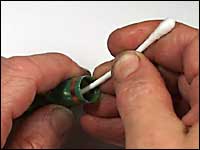 Depending on the pen model, there are several different methods you can try. Here are a few, from the least aggressive to the most. Depending on the pen model, there are several different methods you can try. Here are a few, from the least aggressive to the most.
The first method to try is soaking. Use water or a solution of 1 part clear household ammonia to 10 parts water. Don’t go for more aggressive solvents, because they can — and will — damage your pen. After you’ve let the parts soak a few minutes, add a little elbow grease and a cotton swab as shown in the first illustration, and you can extract an amazing amount of ink from even an apparently clean cap. The most important place to ply your swab is at the lip of the inner cap; this is where ink really builds up. Another place to work at is the threads; I’ll have more to say about threads later.
 Next in the order of things to use is a paper towel. Twist a corner of the towel to form a spear, and “screw” it into the cap, turning in the direction that will keep the towel twisted, and force it all the way down into the farthest recessess of the inner cap. If your spear is too fat, you may need to reshape it. Turn the spear a few times when it’s all the way in, to ensure that it picks up anything loose that’s hiding way down in there. Moistening the towel will often help here, and repeated applications of soaking, swabbing, and toweling will often produce a sparkling clean cap. Next in the order of things to use is a paper towel. Twist a corner of the towel to form a spear, and “screw” it into the cap, turning in the direction that will keep the towel twisted, and force it all the way down into the farthest recessess of the inner cap. If your spear is too fat, you may need to reshape it. Turn the spear a few times when it’s all the way in, to ensure that it picks up anything loose that’s hiding way down in there. Moistening the towel will often help here, and repeated applications of soaking, swabbing, and toweling will often produce a sparkling clean cap.
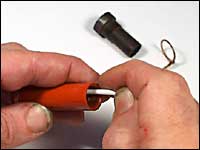 Some pen caps come apart easily; all you need to do is unscrew the end cap. (It might be tight, so you may need to soak it to free the threads or even apply a little heat to soften some shellac. Heat is very aggressive, so please be careful! If you aren’t experienced with heat, you’re probably better off not using it in this application.) Once you have a cap apart, you can clean both the main cap and the inner cap. Some pen caps come apart easily; all you need to do is unscrew the end cap. (It might be tight, so you may need to soak it to free the threads or even apply a little heat to soften some shellac. Heat is very aggressive, so please be careful! If you aren’t experienced with heat, you’re probably better off not using it in this application.) Once you have a cap apart, you can clean both the main cap and the inner cap. The list of pens that you can do this to includes not only the vintage Parker Duofold (shown to the right), True Blue, and Pastels (1920s) but also the Jack-Knife (1910s) and the DQ, some Challengers, and the Televisor (1930s). And — surprise! — there are quite a few modern pens whose caps come apart this way, such as Pelikans (shown to the left) and the Montblanc Meisterstück series. Especially with the transparent Pelikan demonstrators, the ability to take caps apart this way can prove valuable. The list of pens that you can do this to includes not only the vintage Parker Duofold (shown to the right), True Blue, and Pastels (1920s) but also the Jack-Knife (1910s) and the DQ, some Challengers, and the Televisor (1930s). And — surprise! — there are quite a few modern pens whose caps come apart this way, such as Pelikans (shown to the left) and the Montblanc Meisterstück series. Especially with the transparent Pelikan demonstrators, the ability to take caps apart this way can prove valuable.
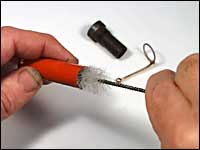 While you’re struggling with the main cap on those that come apart, stop and think. How can you do this more easily? If you have a test-tube brush or a similar one (perhaps you received one with your coffeemaker), you can use the brush to get tough inside the main cap as shown to the right. Use both an end-to-end motion and a screwing motion (twisting in both directions); this will help to extract bits of ink from the threads. You can also use the brush in the inner cap and in caps that won’t come apart, but it typically can’t get all the way down, so you’ll still need swabs or paper towels, or both. Be careful, though; the stiff nylon bristles of some brushes are harder than the plastic of the pen cap, and sometimes they’re also cut off at a sharp angle to make them more aggressive. Applying a brush like this to a pen cap can damage the inside surface, and that really looks lousy if you do it to a transparent demonstrator! While you’re struggling with the main cap on those that come apart, stop and think. How can you do this more easily? If you have a test-tube brush or a similar one (perhaps you received one with your coffeemaker), you can use the brush to get tough inside the main cap as shown to the right. Use both an end-to-end motion and a screwing motion (twisting in both directions); this will help to extract bits of ink from the threads. You can also use the brush in the inner cap and in caps that won’t come apart, but it typically can’t get all the way down, so you’ll still need swabs or paper towels, or both. Be careful, though; the stiff nylon bristles of some brushes are harder than the plastic of the pen cap, and sometimes they’re also cut off at a sharp angle to make them more aggressive. Applying a brush like this to a pen cap can damage the inside surface, and that really looks lousy if you do it to a transparent demonstrator!
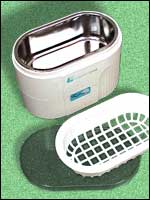 You can also try running yor pen’s cap, either assembled or in pieces, through an ultrasonic cleaner. You’re less likely to destroy the cap with one of the small hobby cleaners than with a more powerful industrial model. The big guys are much more aggressive, and they can put enough energy into the water to extend existing cracks (possibly even splitting the cap if the crack is bad enough) or blister a surface that is pitted or scratched all over through ordinary use. I use the cleaner shown here, which you can buy from several sources, including Micromark. When you buy an ultrasonic cleaner, the thing to look for is the operating frequency. Very cheap “ultrasonic” cleaners don’t actually operate at ultrasonic frequencies, and these machines do little more than extract money from your wallet. A real ultrasonic cleaner operates at a frequency of 40 KHz or higher. You can also try running yor pen’s cap, either assembled or in pieces, through an ultrasonic cleaner. You’re less likely to destroy the cap with one of the small hobby cleaners than with a more powerful industrial model. The big guys are much more aggressive, and they can put enough energy into the water to extend existing cracks (possibly even splitting the cap if the crack is bad enough) or blister a surface that is pitted or scratched all over through ordinary use. I use the cleaner shown here, which you can buy from several sources, including Micromark. When you buy an ultrasonic cleaner, the thing to look for is the operating frequency. Very cheap “ultrasonic” cleaners don’t actually operate at ultrasonic frequencies, and these machines do little more than extract money from your wallet. A real ultrasonic cleaner operates at a frequency of 40 KHz or higher.
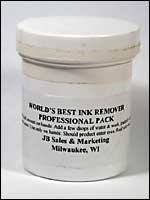 I mentioned earlier that I’d have something to say here about threads. Look around, and make sure nobody is reading over your shoulder, because I am about to give you a trade secret. To clean cap threads and barrel threads, consider trying John Bull’s fabulous product, WORLD’S BEST INK REMOVER. I’ve used it on all sorts of plastic pens, and I believe it’s safe for those materials. It appears to remove a little of the surface from hard rubber, so think twice before using it on that minty RHR Duofold! Follow the instructions very carefully. Gently rub a little of the product into the threads; inside a cap you can do this with a cotton swab, but your fingers will work fine on barrel threads. Give it a minute or so to work, then add a very small amount of water and massage for a few moments as if you were washing your hands. The ink remover becomes slippery like soap. Add a little more water, massage some more, and finally run clear water on the part to wash off the ink remover. This will not always remove all the ink. Threads that were cut rather than molded are frequently rough surfaced, and ink can lodge in the pits and valleys of the surface. But I find that this technique does an amazing job of refreshing cap and barrel threads; with it I‘ve turned a pen that looked like a real loser into one that looks virtually new. Oh, and you can use World’s Best to clean your hands, too. I mentioned earlier that I’d have something to say here about threads. Look around, and make sure nobody is reading over your shoulder, because I am about to give you a trade secret. To clean cap threads and barrel threads, consider trying John Bull’s fabulous product, WORLD’S BEST INK REMOVER. I’ve used it on all sorts of plastic pens, and I believe it’s safe for those materials. It appears to remove a little of the surface from hard rubber, so think twice before using it on that minty RHR Duofold! Follow the instructions very carefully. Gently rub a little of the product into the threads; inside a cap you can do this with a cotton swab, but your fingers will work fine on barrel threads. Give it a minute or so to work, then add a very small amount of water and massage for a few moments as if you were washing your hands. The ink remover becomes slippery like soap. Add a little more water, massage some more, and finally run clear water on the part to wash off the ink remover. This will not always remove all the ink. Threads that were cut rather than molded are frequently rough surfaced, and ink can lodge in the pits and valleys of the surface. But I find that this technique does an amazing job of refreshing cap and barrel threads; with it I‘ve turned a pen that looked like a real loser into one that looks virtually new. Oh, and you can use World’s Best to clean your hands, too. 
Email your question to the Pen Doctor! |
Questions will be answered only through this column on the Pentrace Web site. We regret that time does not permit the Pen Doctor to give a personal reply to every question. |
|